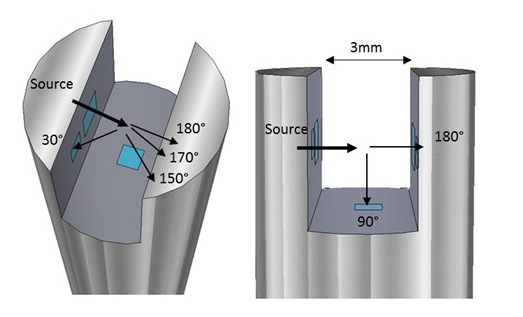R&D work in the field of process monitoring aims to gain a better understanding of the phenomena involved, increase productivity and enhance safety. In this context, Near Infrared Spectroscopy (NIRS), combined with multivariate data analysisa, offers a number of advantages for monitoring processes. This non-destructive and rapid technique requires little or no sample preparation and can be used relatively easily for on-line measurement.
The value of NIRS resides in its capacity to provide both physical (relative to diffusion) and chemical (relative to absorption) information about the product, thanks to the interaction between light and matter. However, in the case of heterogeneous and/or complex media, this information is combined and the measurement of the signal at a single point may prove to be insufficient.
To overcome this difficulty, one of the solutions is to have access to several measurements, by reflection and/or transmission at different angles (figure), and to apply appropriate multivariate analysis methods to the spectra obtained. With this in mind, multipoint NIRS was evaluated on several cases.
For example, during the peptization of boehmiteb in an environment representative of industrial conditions, in situ real-time monitoring made it possible to determine the key parameters. In another field, multipoint NIRS was used to determine the cold properties of crude oil, resulting in a patent. Similarly, for the on-line monitoring of products that evolve significantly over time: changing from a clear to a turbid state, for example. This was verified during the monitoring of silica precipitation(1,2).

These studies have made it possible to verify that multipoint measurements using NIRS provide more information on heterogeneous media, and at the same time improving precision. Consequently they are increasingly being studied for the monitoring of IFPEN’s pilot units.
a - Statistical methods for the simultaneous observation and treatment of several statistical variables with a view to identifying relevant synthetic information.
b - Step in the manufacture of alumina catalyst supports.
(1) M. Rey-Bayle, R. Bendoula, S. Henrot, K. Lamiri, F. Baco-Antoniali, N. Caillol, A. Gobrecht, J-M. Roger. Analytical and bioanalytical chemistry 2017.
DOI :10.1007/s00216-016-0064-1
(2) M. Rey-Bayle, R. Bendoula, N. Caillol, J-M. Roger. Journal of Near Infrared Specroscopy 2019. Submission accepted.
Scientific contact: maud.rey-bayle@ifpen.fr






